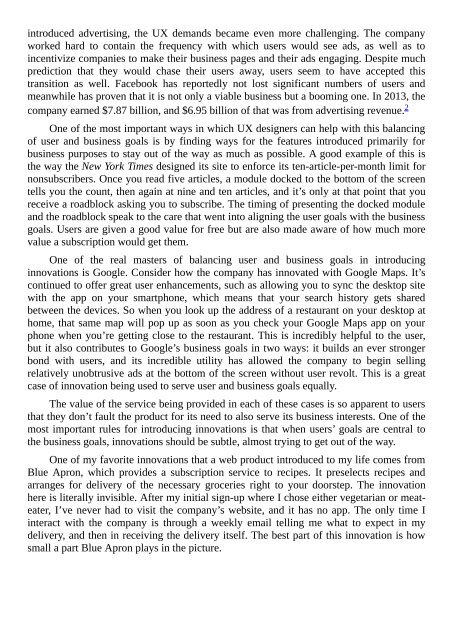Create successful ePaper yourself
Turn your PDF publications into a flip-book with our unique Google optimized e-Paper software.
introduced advertising, the UX demands became even more challenging. The company<br />
worked hard to contain the frequency with which users would see ads, as well as to<br />
incentivize companies to make their business pages and their ads engaging. Despite much<br />
prediction that they would chase their users away, users seem to have accepted this<br />
transition as well. Facebook has reportedly not lost significant numbers of users and<br />
meanwhile has proven that it is not only a viable business but a booming one. In 2013, the<br />
company earned $7.87 billion, and $6.95 billion of that was from advertising revenue. 2<br />
One of the most important ways in which UX designers can help with this balancing<br />
of user and business goals is by finding ways for the features introduced primarily for<br />
business purposes to stay out of the way as much as possible. A good example of this is<br />
the way the New York Times designed its site to enforce its ten-article-per-month limit for<br />
nonsubscribers. Once you read five articles, a module docked to the bottom of the screen<br />
tells you the count, then again at nine and ten articles, and it’s only at that point that you<br />
receive a roadblock asking you to subscribe. The timing of presenting the docked module<br />
and the roadblock speak to the care that went into aligning the user goals with the business<br />
goals. <strong>User</strong>s are given a good value for free but are also made aware of how much more<br />
value a subscription would get them.<br />
One of the real masters of balancing user and business goals in introducing<br />
innovations is Google. Consider how the company has innovated with Google Maps. It’s<br />
continued to offer great user enhancements, such as allowing you to sync the desktop site<br />
with the app on your smartphone, which means that your search history gets shared<br />
between the devices. So when you look up the address of a restaurant on your desktop at<br />
home, that same map will pop up as soon as you check your Google Maps app on your<br />
phone when you’re getting close to the restaurant. This is incredibly helpful to the user,<br />
but it also contributes to Google’s business goals in two ways: it builds an ever stronger<br />
bond with users, and its incredible utility has allowed the company to begin selling<br />
relatively unobtrusive ads at the bottom of the screen without user revolt. This is a great<br />
case of innovation being used to serve user and business goals equally.<br />
The value of the service being provided in each of these cases is so apparent to users<br />
that they don’t fault the product for its need to also serve its business interests. One of the<br />
most important rules for introducing innovations is that when users’ goals are central to<br />
the business goals, innovations should be subtle, almost trying to get out of the way.<br />
One of my favorite innovations that a web product introduced to my life comes from<br />
Blue Apron, which provides a subscription service to recipes. It preselects recipes and<br />
arranges for delivery of the necessary groceries right to your doorstep. The innovation<br />
here is literally invisible. After my initial sign-up where I chose either vegetarian or meateater,<br />
I’ve never had to visit the company’s website, and it has no app. The only time I<br />
interact with the company is through a weekly email telling me what to expect in my<br />
delivery, and then in receiving the delivery itself. The best part of this innovation is how<br />
small a part Blue Apron plays in the picture.


